The UK-India Trade Deal: July 2025 Free Trade Agreement—Who Wins, Who Gains?
Just 48 hours ago, history was made when Prime Ministers Narendra Modi and Keir Starmer signed the most comprehensive free trade agreement between the UK and India since their post-colonial relationship began. This landmark Comprehensive Economic and Trade Agreement (CETA), inked on July 24, 2025, promises to double bilateral trade to $112 billion by 2030 and reshape the economic landscape for both democracies. After three years of intense negotiations spanning 15 rounds, this deal emerges as Britain’s largest post-Brexit trade victory and India’s most ambitious bilateral agreement with a developed economy.
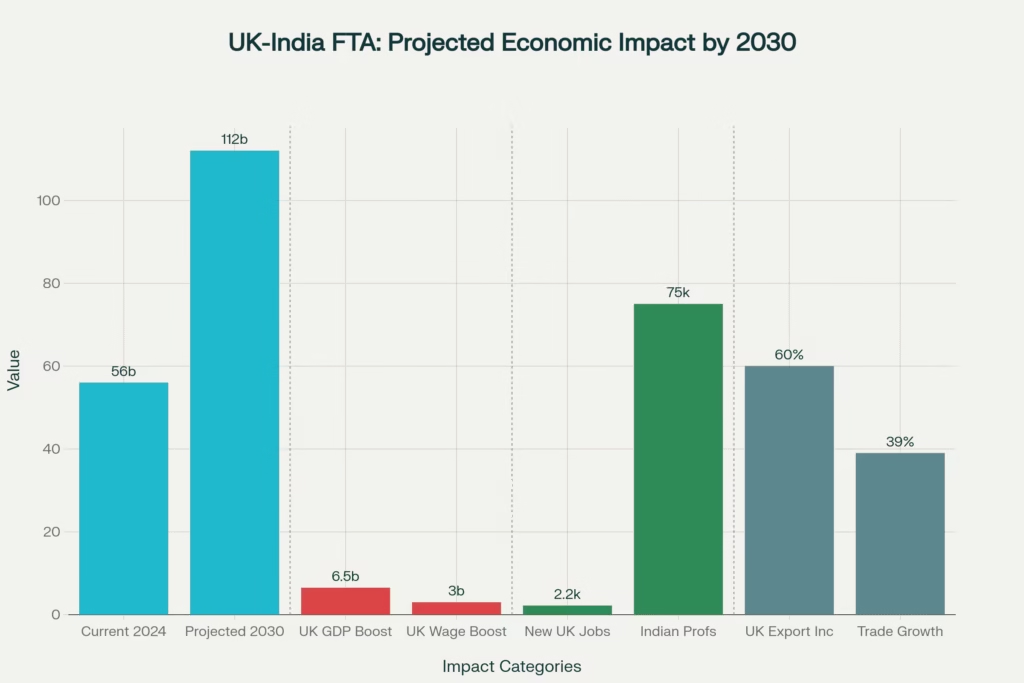
UK-India FTA Economic Impact Projections showing trade volumes, GDP benefits, job creation, and growth forecasts through 2030
The agreement eliminates tariffs on 99% of Indian exports to the UK while India reciprocates by reducing duties on 90% of British goods, with 85% becoming completely duty-free within a decade. From Yorkshire whisky distilleries to Mumbai textile factories, from London financial services to Kerala’s fishing communities, this FTA promises to transform lives and livelihoods across both nations. But who truly benefits from this historic handshake, and what does it mean for consumers, workers, and businesses on both sides of the Arabian Sea?
What is the UK-India Free Trade Agreement? (FTA Basics & Timeline)
The India-UK CETA represents far more than a traditional tariff-cutting exercise. This 27-chapter agreement encompasses goods and services trade, digital commerce, government procurement, intellectual property rights, labor mobility, and environmental safeguards making it India’s most comprehensive F traces back to May 2021 when Boris Johnson and Narendra Modi agreed on an “Enhanced Trade Partnership,” but negotiations officially launched in January 2022.
The path to signature was tumultuous, surviving the chaos of four British Prime Ministers between 2022 and 2025. Johnson’s ambitious Diwali 2022 deadline came and went, hampered by political upheaval in Westminster and complex sticking points around visa policies, agricultural access, and intellectual property protections. The breakthrough came under Keir Starmer’s Labour government in May 2025, catalyzed by the urgent need to counter President Trump’s disruptive “Liberation Day” reciprocal tariff policies that threatened global trade stability.
People Also Ask: How does this compare to RCEP or EU FTAs?
The UK-India FTA surpasses regional agreements like RCEP in scope, particularly for digital services and professional mobility provisions. Unlike most EU agreements, this deal includes robust chapters on labor rights, gender equality, and anti-corruption areas India has never previously committed to in trade pacts. The agreement’s mixed scheduling approach for services ensures the UK receives India’s best market access terms given to any future FTA partner.
Sectoral Winners: Where Are the Biggest Gains?
Indian Textiles, Leather, and MSMEs
Indian textile and leather exporters are positioned for transformational growth. The UK’s elimination of 10-12% tariffs on Indian textiles immediately levels the playing field against competitors like Bangladesh and Cambodia who enjoyed preferential access. With the UK importing $27 billion worth of textiles annually and India currently capturing only 6.6% of this market despite being the fourth-largest supplier the untapped potential is enormous.
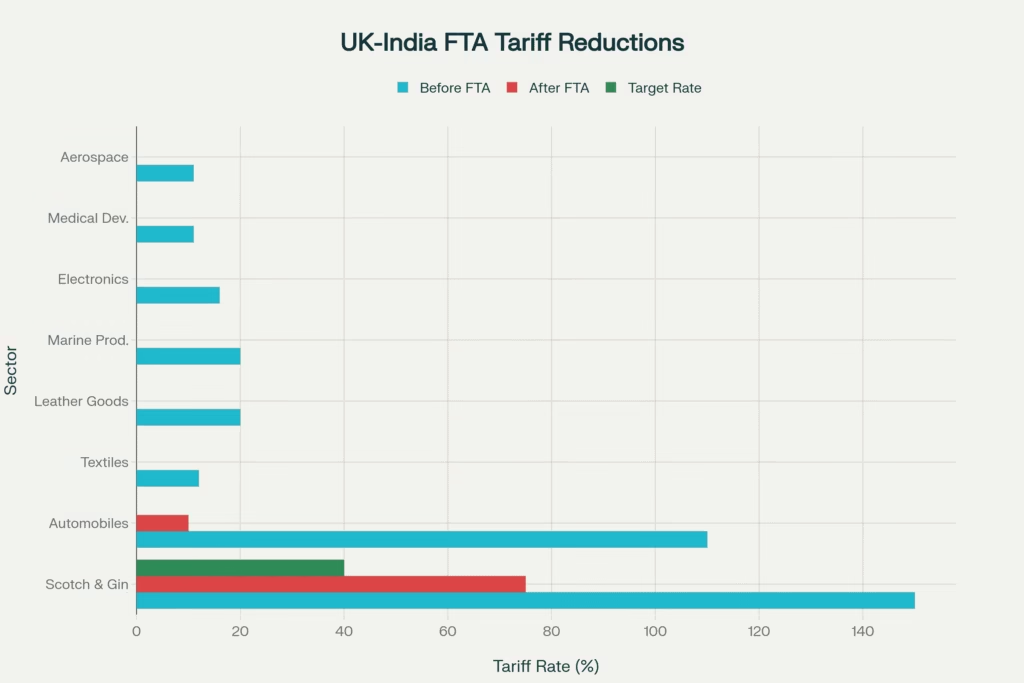
Sectoral tariff reductions showing before and after rates under the UK-India FTA across key export/import categories
The Micro, Small, and Medium Enterprise (MSME) sector emerges as the agreement’s biggest winner. Federation of Indian Micro and Small & Medium Enterprises (FISME) hailed the deal as “historic,” noting that labor-intensive sectors previously facing duties of 4-70% now enjoy zero-duty access. Home textile exporters project a 10% rise in exports, potentially adding 200,000-500,000 jobs over five years. Welspun, Raymond, and Arvind Ltd are among major textile manufacturers expected to benefit significantly.
Key MSME benefits include:
- Duty-free quota access for textiles, apparel, and leather goods
- Public procurement opportunities in the UK market worth $122 billion
- Technical assistance funds to help MSMEs adapt to UK standards
- Streamlined customs procedures reducing compliance costs
UK Whisky, Automotive, and Digital Services
British whisky producers have struck liquid gold. India’s reduction of import duties from 150% to 75% immediately, declining to 40% over a decade, transforms the world’s largest whisky market by volume into an accessible opportunity. Premium brands like Johnnie Walker Black Label and Chivas Regal are expected to become Rs 200-300 cheaper per bottle, while standard brands may drop by Rs 100-150.
UK automotive manufacturers gain substantially from India’s automotive tariff reduction from over 100% to 10% under a quota system. This makes British premium vehicles 15-20% more affordable for Indian consumers, potentially boosting annual sales to exceed 50,000 units by 2030. Jaguar Land Rover, with its established Indian presence, stands to benefit significantly from this tariff arbitrage.
The digital services revolution represents perhaps the UK’s greatest long-term gain. British fintech, edtech, and consulting firms secure easier market entry through enhanced cross-border data flow provisions and IP protections. The agreement prohibits customs duties on electronic transmissions a significant concession from India, which traditionally opposed such measures at the WTO.
Agriculture: The Rural Boost
Indian agricultural exporters gain duty-free access on 95% of agricultural tariff lines, including spices, basmati rice, mango pulp, and processed foods. The UK’s $375 billion agricultural import market opens new opportunities for jackfruit, millets, and organic herbs emerging products that help farmers diversify against domestic price volatility.
India’s marine products sector, particularly shrimp and seafood from Andhra Pradesh, Odisha, Kerala, and Tamil Nadu, benefits from zero-duty access to the UK’s $5.4 billion marine import market. Previously facing tariffs up to 20%, Indian seafood exporters now compete on equal terms, directly benefiting coastal communities and traditional fishing industries.
Technology & Startups: The New Bridge
The FTA’s “Digital Bridge” initiative facilitates cross-border data flows and regulatory cooperation while establishing mutual recognition frameworks for digital services. Indian startups in AI, blockchain, and SaaS gain special access to UK accelerator programs, while British tech companies secure footholds in India’s smart city and fintech projects.
Electronics and software exports receive a significant boost:
- Zero-duty access for smartphones, optical fiber cables, and inverters
- 15-20% annual growth projected for software services from the current $32 billion base
- Streamlined customs processes reducing entry barriers for SMEs
Who Benefits Most? Labor, Professionals, and the Middle Class
The agreement’s labor mobility provisions represent a paradigm shift in post-Brexit immigration cooperation. The deal creates guaranteed visa access for Indian professionals across multiple categories while introducing innovative social security arrangements.
Indian professionals gain:
- Access to 35 UK service sectors for up to 2 years without requiring local office presence
- Annual quota of 1,800 visas for cultural professionals chefs, yoga instructors, musicians
- Social security exemption for 75,000+ Indian workers for 3 years under the Double Contribution Convention
- Mutual recognition frameworks for qualifications in engineering, medicine, and accountancy
For Indian middle-class consumers:
- 15-20% price reductions on UK cars, whisky, and electronics over 5 years
- Enhanced job opportunities in export-oriented sectors
- Cheaper access to British medical devices, cosmetics, and processed foods
For British workers:
- Over 2,200 new jobs from Indian investments and export opportunities
- £2.2 billion annual wage boost across UK regions
- Skills exchange partnerships with Indian technology firms
Sidebar FAQ: Will the trade deal lower car and whisky prices in India?
Yes, UK automotive tariffs drop from 110% to 10%, potentially making premium cars 15-20% cheaper. Scotch whisky duties halve immediately to 75%, with further reductions to 40% over a decade, translating to Rs 200-300 savings per premium bottle.
Bilateral Trade in Numbers: Targets for 2030 and Beyond
The FTA sets ambitious numerical targets that reflect both countries’ confidence in the agreement’s transformative potential. Current bilateral trade of $56 billion aims to double to $112-120 billion by 2030, representing a 39% increase in annual bilateral commerce.
Sector projections reveal the scale of opportunity:
The agreement promises to generate over 250,000 jobs in India, predominantly in MSMEs and export-led sectors, while creating 70,000+ jobs in the UK. UK GDP receives an estimated £4.8 billion annual boost, with £15.7 billion in additional exports by 2040.
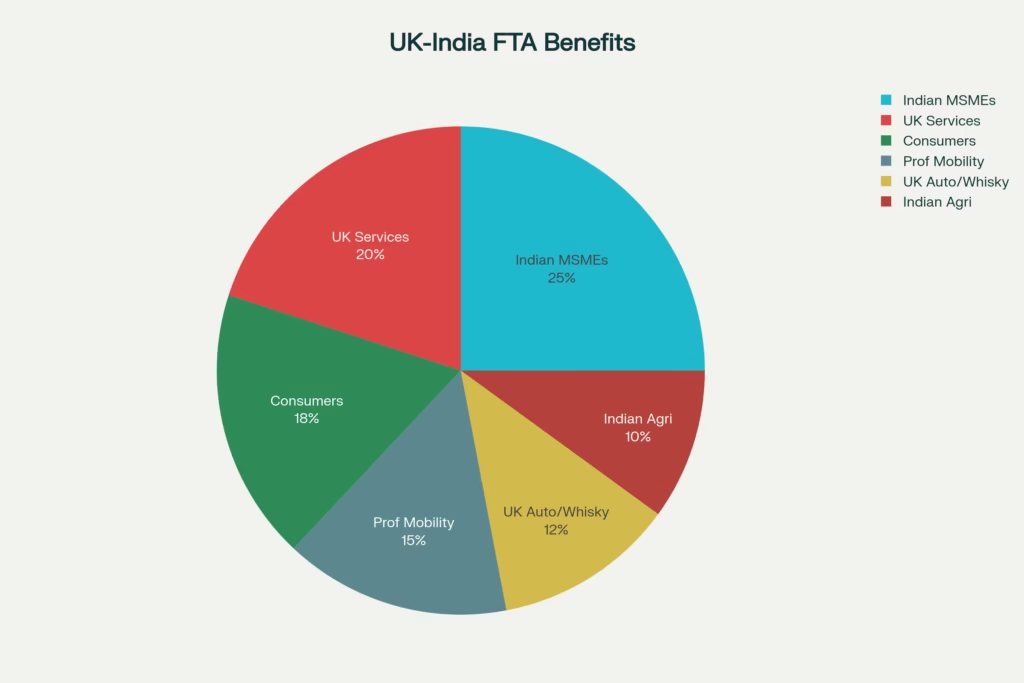
Distribution of projected benefits from the UK-India FTA across different stakeholder groups showing relative impact shares
People Also Ask: How does this compare to RCEP or EU FTAs?
The UK-India FTA exceeds RCEP in digital services inclusion and surpasses most EU agreements in professional mobility provisions. India’s services commitments use a “mixed scheduling approach” ensuring the UK always receives India’s best terms a provision absent in regional agreements.
Winners & Challenges: SME Expansion and Overshadowed Sectors
While the FTA creates numerous winners, sectoral challenges and adaptation hurdles remain significant. The agreement’s complexity demands strategic navigation from businesses seeking to capitalize on new opportunities.
Clear Winners:
- Indian textile and leather MSMEs facing immediate tariff elimination
- UK spirits industry accessing the world’s largest whisky market
- British automotive sector penetrating India’s luxury car segment
- Indian IT services companies benefiting from enhanced mobility provisions
- Both countries’ consumers enjoying greater choice and lower prices
Overshadowed and Challenged Sectors:
- Indian dairy and automotive components face intensified UK competition
- UK domestic textiles may struggle against cheaper Indian imports
- Indian pharmaceuticals navigate enhanced IP protections while maintaining generic drug production
- Traditional UK agriculture competes with duty-free Indian spices and processed foods
SME Adaptation Challenges:
MSMEs in both countries confront adjustment curves requiring new compliance, quality, and sustainability standards. While the agreement provides technical and financial assistance, entrepreneurs must rapidly adapt or risk exclusion from new opportunities. The L1 procurement system in India may disadvantage UK firms despite relaxed rules, as British companies struggle to compete on pure price metrics.
Supply chain and logistics improvements become critical success factors. The agreement’s 48-hour customs clearance commitment and paperless trade provisions offer efficiency gains, but require infrastructure upgrades and digitization investments.
Political and Strategic Dimensions
The UK-India FTA transcends commercial considerations, representing a geopolitical realignment in the post-Brexit, post-pandemic world order. For Britain, the agreement signals successful re-emergence as an independent trading power, countering critics who questioned post-EU global influence.
Strategic significance for the UK:
- Largest post-Brexit trade deal demonstrating global trade policy success
- Access to world’s fastest-growing major economy with 1.4 billion consumers
- Counterweight to EU dependency through Indo-Pacific partnerships
- Template for future agreements with other Commonwealth and developing nations
Strategic value for India:
- First comprehensive FTA with developed Western economy in over a decade
- Blueprint for EU and US negotiations showcasing India’s deal-making capability
- “China-plus-one” diversification reducing supply chain dependencies
- Services sector globalization enhancing India’s competitive positioning
The timing proves crucial amid global trade disruptions. President Trump’s reciprocal tariff policies and ongoing US-China tensions create urgency for alternative trading relationships. Both nations position the FTA as stability-enhancing in an uncertain global economy, with India’s strategic autonomy and UK’s post-Brexit sovereignty reinforcing mutual interests.
The agreement includes unprecedented sustainability and governance commitments:
- India’s first-ever chapters on anti-corruption, labor rights, and gender equality in an FTA
- Climate cooperation provisions supporting net-zero transitions
- Digital governance frameworks balancing innovation with data protection
FAQs: Your Top UK-India FTA Questions, Answered
Q: Will the FTA impact student mobility between India and the UK?
A: Yes, the agreement includes enhanced visa processing and expanded internship quotas for Indian students, particularly in STEM and business disciplines. While not creating new visa categories, it provides greater predictability and streamlined procedures.
Q: Are there review mechanisms to adjust the agreement over time?
A: The FTA establishes annual Joint Committee reviews to monitor market effects, update product lists, and adjust labor mobility rules. A dedicated subcommittee on sustainability ensures environmental and social commitments evolve with changing circumstances.
Q: What sectors remain excluded or protected?
A: Both countries retained sensitive sector protections. India excludes railways, food corporation procurement, and MSME-specific policies from UK access. The UK maintains regulatory autonomy over immigration thresholds and national security considerations.
Q: How quickly will businesses see benefits?
A: Immediate benefits include halved whisky tariffs and eliminated textile duties. However, full implementation requires 1-2 years pending UK Parliamentary ratification and Indian Cabinet approval. Businesses should begin compliance planning now to capitalize on early opportunities.
Q: Does the agreement affect India’s generic drug manufacturing?
A: The FTA includes IP protections but specifically preserves India’s ability to produce affordable generic medicines. UK officials confirmed the deal will not hinder India’s provision of generic drugs to global markets.
What to Watch Next: Future Deals, Policy Shifts, and Consumer Tips
The UK-India FTA sets precedents and templates for upcoming negotiations that could reshape global trade architecture. Both governments are leveraging this success to accelerate broader economic partnerships.
Immediate developments to monitor:
- EU-India negotiations resume with enhanced momentum, targeting conclusion by 2026
- US-India discussions intensify ahead of potential August 2025 tariff increases
- CPTPP membership for both UK and India gains renewed consideration
- Investment treaty negotiations between UK and India continue separately
Policy evolution areas:
- E-commerce regulations through joint taskforces harmonizing cross-border digital trade rules
- Sustainability standards evolving through annual reviews and green product certification
- Professional qualification recognition expanding beyond initial sectors
Consumer and business preparation tips:
- UK retailers should prepare for special FTA-compliant product labeling by late 2025
- Indian exporters must begin sustainability audits to meet evolving green standards
- Professional service providers should explore mutual recognition opportunities in accounting, engineering, and healthcare
- SMEs should engage dedicated FTA support contact points for market entry guidance
The agreement’s demonstration effect already influences global trade negotiations. The EU accelerates India talks while considering similar professional mobility provisions, while the US evaluates comparable sectoral approaches for its own India negotiations.
Calls-to-Action and Strategic Recommendations
The UK-India FTA represents more than historical significance it offers immediate actionable opportunities for businesses, professionals, and policymakers across both nations.
For Indian Businesses:
- Textile and leather companies should immediately assess UK market entry strategies and compliance requirements
- IT services firms must prepare for enhanced mobility provisions and explore UK partnership opportunities
- Agricultural exporters should evaluate organic certification and traceability systems for UK market access
- MSMEs should engage FTA support mechanisms and explore UK government procurement opportunities
For UK Enterprises:
- Whisky and automotive companies should develop India market penetration strategies leveraging reduced tariffs
- Digital services firms must understand India’s data localization rules and cross-border flow provisions
- Professional services should explore qualification recognition opportunities and establish Indian partnerships
- Manufacturing companies should assess India as a production base for global export strategies
For Policymakers and Trade Practitioners:
- Monitor implementation of sustainability and labor provisions as templates for future agreements
- Assess spillover effects on ongoing EU-India and US-India negotiations
- Evaluate supply chain diversification opportunities through UK-India partnerships
- Study professional mobility provisions as models for skills-based immigration policy
The July 2025 UK-India FTA transcends traditional commercial agreements, embodying a strategic partnership between two of the world’s largest democracies. As both nations race toward projected $112 billion bilateral trade by 2030, success will depend on rapid adaptation, strategic implementation, and continued political commitment to economic integration.
For businesses ready to seize opportunities, professionals seeking global mobility, and consumers anticipating greater choice and lower prices, the UK-India FTA offers a blueprint for prosperity in an increasingly interconnected world. The winners will be those who act swiftly, adapt intelligently, and leverage this historic agreement to build bridges across the Arabian Sea and beyond.
Further Reading & Resources:
- [Explore UK business expansion opportunities post-Brexit] – UK Department for Business and Trade resources
- [Learn more about India’s broader FTA network] – Ministry of Commerce and Industry trade policy updates
- [Discover MSME export opportunities] – Federation of Indian MSMEs guidance and support programs
- [Access UK-India professional mobility guidance] – Home Office and Immigration Services information portals
Keywords: UK India FTA, UK India trade deal, Free Trade Agreement 2025, Sectoral impacts UK India FTA, MSME opportunities UK India, UK whisky exports to India, Indian textiles in UK, job creation India UK FTA, consumer price impact FTA, professional mobility UK India, UK India FTA comparison, post-Brexit trade deals UK, digital services UK India, sustainability clauses UK India FTA, economic forecast UK India, bilateral trade growth UK India, tariff reduction FTA, agriculture UK India trade, technology startups UK India, UK business incentives, India FTA network
Disclaimer: Transparency is important to us! This blog post was generated with the help of an AI writing tool. Our team has carefully reviewed and fact-checked the content to ensure it meets our standards for accuracy and helpfulness. We believe in the power of AI to enhance content creation, but human oversight is essential.

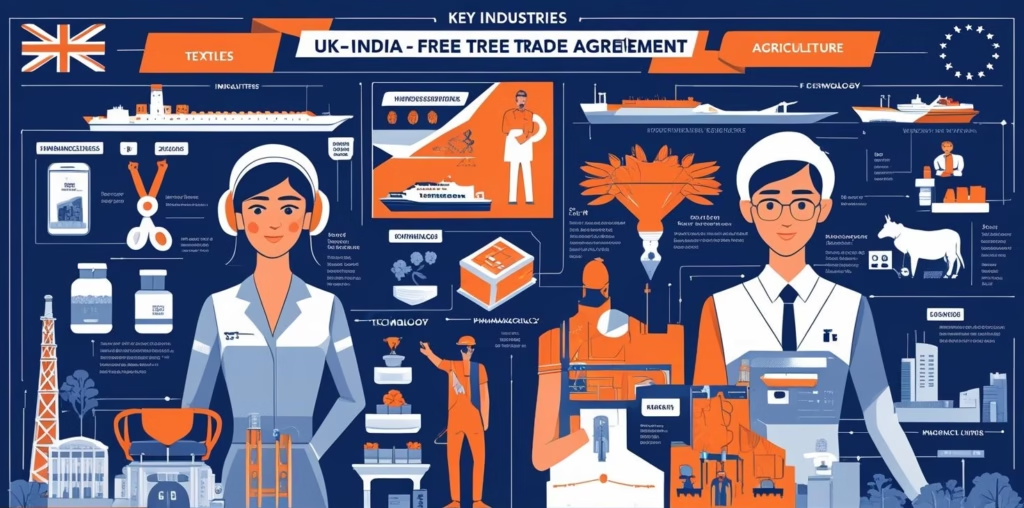


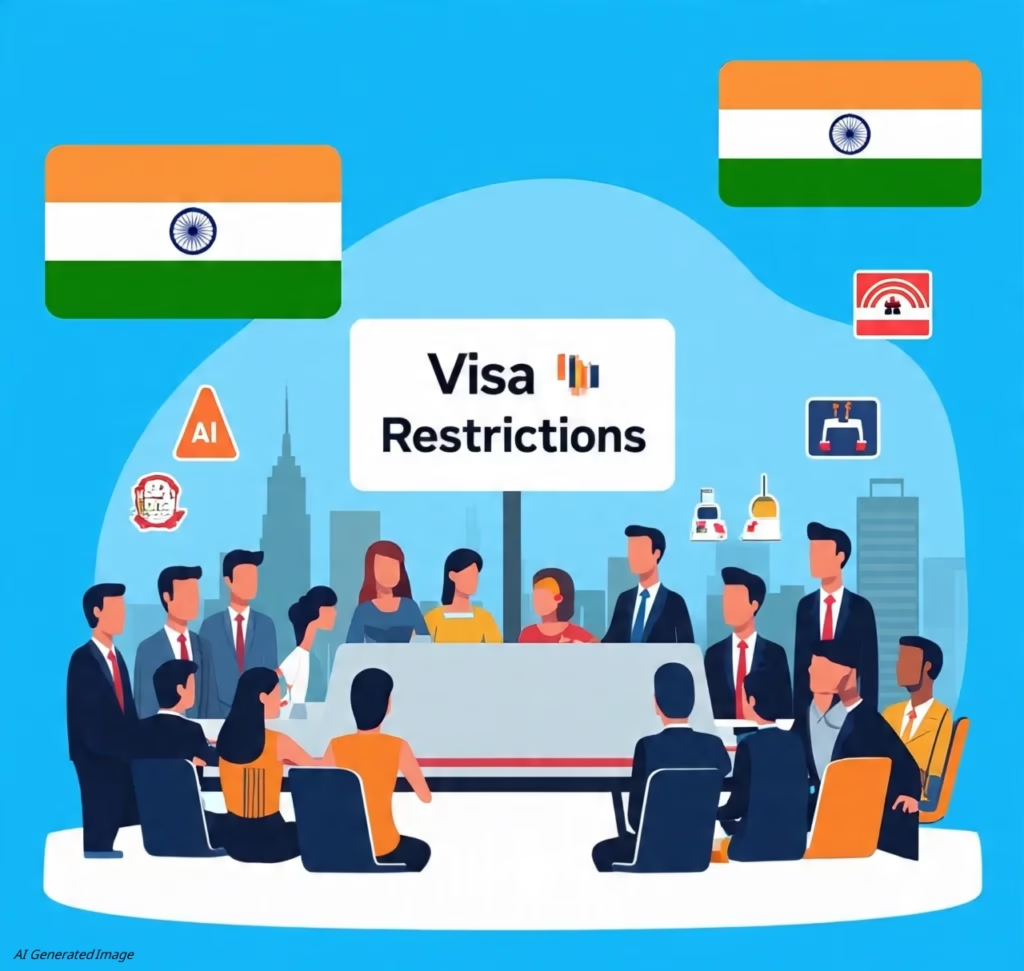
Hello there, just became alert to your blog through Google, and found that it is truly informative. I am gonna watch out for brussels. I’ll be grateful if you continue this in future. Many people will be benefited from your writing. Cheers!
Thank you so much for your kind words! I’m really glad you found the content here useful. At AiTechQuest, we’ll keep sharing more high-quality blogs and insights on AI, tech and latest headlines to make it worth your regular visits. Looking forward to seeing you around often!
Aitechquest Team